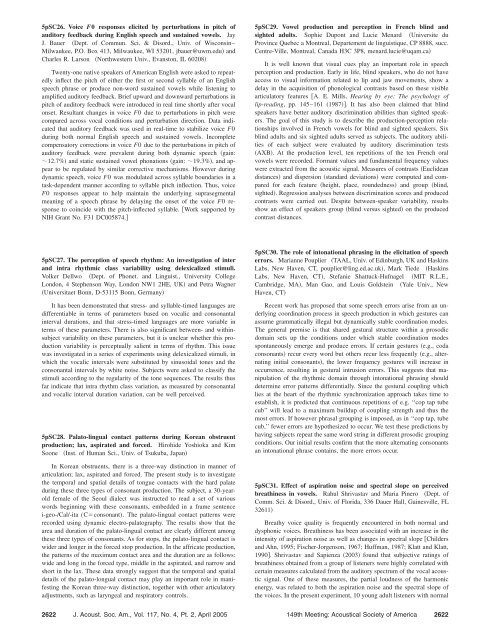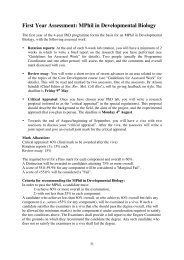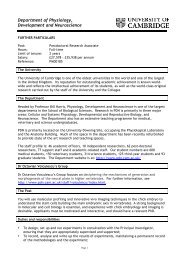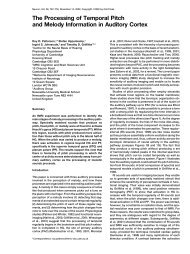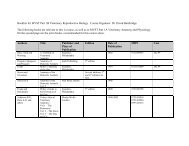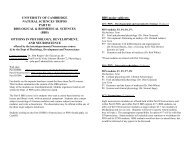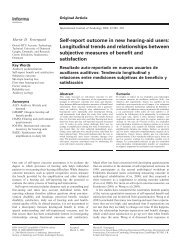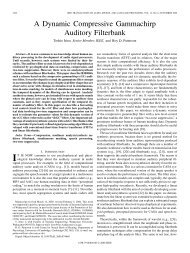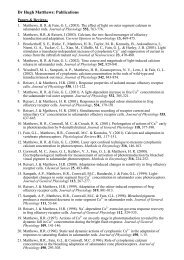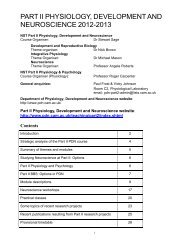FRIDAY MORNING, 20 MAY 2005 REGENCY E, 8:30 A.M. TO 12:00 ...
FRIDAY MORNING, 20 MAY 2005 REGENCY E, 8:30 A.M. TO 12:00 ...
FRIDAY MORNING, 20 MAY 2005 REGENCY E, 8:30 A.M. TO 12:00 ...
Create successful ePaper yourself
Turn your PDF publications into a flip-book with our unique Google optimized e-Paper software.
5pSC26. Voice F0 responses elicited by perturbations in pitch of<br />
auditory feedback during English speech and sustained vowels. Jay<br />
J. Bauer Dept. of Commun. Sci. & Disord., Univ. of Wisconsin–<br />
Milwaukee, P.O. Box 413, Milwaukee, WI 53<strong>20</strong>1, jbauer@uwm.edu and<br />
Charles R. Larson Northwestern Univ., Evanston, IL 60<strong>20</strong>8<br />
Twenty-one native speakers of American English were asked to repeatedly<br />
inflect the pitch of either the first or second syllable of an English<br />
speech phrase or produce non-word sustained vowels while listening to<br />
amplified auditory feedback. Brief upward and downward perturbations in<br />
pitch of auditory feedback were introduced in real time shortly after vocal<br />
onset. Resultant changes in voice F0 due to perturbations in pitch were<br />
compared across vocal conditions and perturbation direction. Data indicated<br />
that auditory feedback was used in real-time to stabilize voice F0<br />
during both normal English speech and sustained vowels. Incomplete<br />
compensatory corrections in voice F0 due to the perturbations in pitch of<br />
auditory feedback were prevalent during both dynamic speech gain:<br />
<strong>12</strong>.7% and static sustained vowel phonations gain: 19.3%, and appear<br />
to be regulated by similar corrective mechanisms. However during<br />
dynamic speech, voice F0 was modulated across syllable boundaries in a<br />
task-dependent manner according to syllable pitch inflection. Thus, voice<br />
F0 responses appear to help maintain the underlying suprasegmental<br />
meaning of a speech phrase by delaying the onset of the voice F0 response<br />
to coincide with the pitch-inflected syllable. Work supported by<br />
NIH Grant No. F31 DC<strong>00</strong>5874.<br />
5pSC29. Vowel production and perception in French blind and<br />
sighted adults. Sophie Dupont and Lucie Menard Universite du<br />
Province Quebec a Montreal, Departement de linguistique, CP 8888, succ.<br />
Centre-Ville, Montreal, Canada H3C 3P8, menard.lucie@uqam.ca<br />
It is well known that visual cues play an important role in speech<br />
perception and production. Early in life, blind speakers, who do not have<br />
access to visual information related to lip and jaw movements, show a<br />
delay in the acquisition of phonological contrasts based on these visible<br />
articulatory features A. E. Mills, Hearing by eye: The psychology of<br />
lip-reading, pp. 145–161 1987. It has also been claimed that blind<br />
speakers have better auditory discrimination abilities than sighted speakers.<br />
The goal of this study is to describe the production-perception relationships<br />
involved in French vowels for blind and sighted speakers. Six<br />
blind adults and six sighted adults served as subjects. The auditory abilities<br />
of each subject were evaluated by auditory discrimination tests<br />
AXB. At the production level, ten repetitions of the ten French oral<br />
vowels were recorded. Formant values and fundamental frequency values<br />
were extracted from the acoustic signal. Measures of contrasts Euclidean<br />
distances and dispersion standard deviations were computed and compared<br />
for each feature height, place, roundedness and group blind,<br />
sighted. Regression analyses between discrimination scores and produced<br />
contrasts were carried out. Despite between-speaker variability, results<br />
show an effect of speakers group blind versus sighted on the produced<br />
contrast distances.<br />
5pSC27. The perception of speech rhythm: An investigation of inter<br />
and intra rhythmic class variability using delexicalized stimuli.<br />
Volker Dellwo Dept. of Phonet. and Linguist., University College<br />
London, 4 Stephenson Way, London NW1 2HE, UK and Petra Wagner<br />
Universitaet Bonn, D-53115 Bonn, Germany<br />
It has been demonstrated that stress- and syllable-timed languages are<br />
differentiable in terms of parameters based on vocalic and consonantal<br />
interval durations, and that stress-timed languages are more variable in<br />
terms of these parameters. There is also significant between- and withinsubject<br />
variability on these parameters, but it is unclear whether this production<br />
variability is perceptually salient in terms of rhythm. This issue<br />
was investigated in a series of experiments using delexicalized stimuli, in<br />
which the vocalic intervals were substituted by sinusoidal tones and the<br />
consonantal intervals by white noise. Subjects were asked to classify the<br />
stimuli according to the regularity of the tone sequences. The results thus<br />
far indicate that intra rhythm class variation, as measured by consonantal<br />
and vocalic interval duration variation, can be well perceived.<br />
5pSC28. Palato-lingual contact patterns during Korean obstruent<br />
production; lax, aspirated and forced. Hirohide Yoshioka and Kim<br />
Soone Inst. of Human Sci., Univ. of Tsukuba, Japan<br />
In Korean obstruents, there is a three-way distinction in manner of<br />
articulation; lax, aspirated and forced. The present study is to investigate<br />
the temporal and spatial details of tongue contacts with the hard palate<br />
during these three types of consonant production. The subject, a <strong>30</strong>-yearold<br />
female of the Seoul dialect was instructed to read a set of various<br />
words beginning with these consonants, embedded in a frame sentence<br />
i-geo-/Cal/-ita (Cconsonant). The palato-lingual contact patterns were<br />
recorded using dynamic electro-palatography. The results show that the<br />
area and duration of the palato-lingual contact are clearly different among<br />
these three types of consonants. As for stops, the palato-lingual contact is<br />
wider and longer in the forced stop production. In the affricate production,<br />
the patterns of the maximum contact area and the duration are as follows:<br />
wide and long in the forced type, middle in the aspirated, and narrow and<br />
short in the lax. These data strongly suggest that the temporal and spatial<br />
details of the palato-longual contact may play an important role in manifesting<br />
the Korean three-way distinction, together with other articulatory<br />
adjustments, such as laryngeal and respiratory controls.<br />
5pSC<strong>30</strong>. The role of intonational phrasing in the elicitation of speech<br />
errors. Marianne Pouplier TAAL, Univ. of Edinburgh, UK and Haskins<br />
Labs, New Haven, CT, pouplier@ling.ed.ac.uk, Mark Tiede Haskins<br />
Labs, New Haven, CT, Stefanie Shattuck-Hufnagel MIT R.L.E.,<br />
Cambridge, MA, Man Gao, and Louis Goldstein Yale Univ., New<br />
Haven, CT<br />
Recent work has proposed that some speech errors arise from an underlying<br />
coordination process in speech production in which gestures can<br />
assume grammatically illegal but dynamically stable coordination modes.<br />
The general premise is that shared gestural structure within a prosodic<br />
domain sets up the conditions under which stable coordination modes<br />
spontaneously emerge and produce errors. If certain gestures e.g., coda<br />
consonants recur every word but others recur less frequently e.g., alternating<br />
initial consonants, the lower frequency gestures will increase in<br />
occurrence, resulting in gestural intrusion errors. This suggests that manipulation<br />
of the rhythmic domain through intonational phrasing should<br />
determine error patterns differentially. Since the gestural coupling which<br />
lies at the heart of the rhythmic synchronization approach takes time to<br />
establish, it is predicted that continuous repetitions of e.g. ‘‘cop tap tube<br />
cub’’ will lead to a maximum buildup of coupling strength and thus the<br />
most errors. If however phrasal grouping is imposed, as in ‘‘cop tap, tube<br />
cub,’’ fewer errors are hypothesized to occur. We test these predictions by<br />
having subjects repeat the same word string in different prosodic grouping<br />
conditions. Our initial results confirm that the more alternating consonants<br />
an intonational phrase contains, the more errors occur.<br />
5pSC31. Effect of aspiration noise and spectral slope on perceived<br />
breathiness in vowels. Rahul Shrivastav and Maria Pinero Dept. of<br />
Comm. Sci. & Disord., Univ. of Florida, 336 Dauer Hall, Gainesville, FL<br />
32611<br />
Breathy voice quality is frequently encountered in both normal and<br />
dysphonic voices. Breathiness has been associated with an increase in the<br />
intensity of aspiration noise as well as changes in spectral slope Childers<br />
and Ahn, 1995; Fischer-Jorgenson, 1967; Huffman, 1987; Klatt and Klatt,<br />
1990. Shrivastav and Sapienza <strong>20</strong>03 found that subjective ratings of<br />
breathiness obtained from a group of listeners were highly correlated with<br />
certain measures calculated from the auditory spectrum of the vocal acoustic<br />
signal. One of these measures, the partial loudness of the harmonic<br />
energy, was related to both the aspiration noise and the spectral slope of<br />
the voices. In the present experiment, 10 young adult listeners with normal<br />
2622 J. Acoust. Soc. Am., Vol. 117, No. 4, Pt. 2, April <strong>20</strong>05 149th Meeting: Acoustical Society of America 2622


